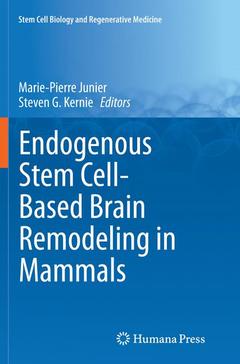Endogenous Stem Cell-Based Brain Remodeling in Mammals, 2014 Stem Cell Biology and Regenerative Medicine Series
Coordonnateurs : Junier Marie-Pierre, Kernie Steven G.

.-1 Introduction
.-Marie-Pierre Junier, Steven G. Kernie
.-2 Structural Plasticity in Adult Nervous System: A Historic Perspective
.-Constantino Sotelo, Isabelle Dusart
.-3 Impact of Injured Tissue on Stem Cell Fate
.-Bobbi Fleiss, Vibol Chhor, Luigi Titomanlio, Stephane Auvin, Olivier Baud, Pierre Gressens
.-4 Role of Neural Stem and Progenitor Cells in the Adaptation of the Brain to Injury
.-Sue Hong, Tzong-Shiue Yu, Steven G. Kernie
.-5 Role of Adult Neurogenesis in Seizure-Induced Hippocampal Remodeling and Epilepsy
.-Alison L. Althaus, Jack M. Parent
.-6 Neurogenesis and Gliogenesis in the Postnatal Hypothalamus: a new level of plasticity for the regulation of hypothalamic function?
.-Ariane Sharif, Sergio R. Ojeda, Vincent Prevot
.-7 Regenerative Potential of NG2 Cells
.-Jean-Marie Mangin
.-8 Oligodendrocyte Progenitors and Brain Remodeling Following Blood Brain Barrier Rupture
.-Praveen Ballabh
.-9 Genomic Integrity of Embryonic and Neural Stem Cells
.-Nathalie Lefort, Marc Peschanski
.-10 Links Between Injury-Induced Brain Remodeling and Oncogenesis?
.-Marie-Pierre Junier, Elias A. El-Habr
Dr. Steven G. Kernie is an Associate Professor of Pediatrics and Pathology & Cell Biology at Columbia University in New York and Chief of Critical Care Medicine at Morgan Stanley Children’s Hospital at Columbia University Medical Center. His laboratory is interested in how the brain repairs itself following injury. The presence of adult neural stem and progenitor cells in the mammalian brain has awakened new interest and optimism in potential treatment for a variety of acquired brain disorders. The Kernie lab is investigating how adult neural stem and progenitor cells participate in injury-induced remodeling and in identifying genes and drugs that might be important in augmenting their contribution. In order to do this, they have generated a variety of transgenic mice that allow for temporally controlled alterations in the endogenous stem cell population in order to optimize the post-injury remodeling that occurs.
Dr. Marie-Pierre Junier is Research Director at Inserm and co-PI of team Glial Plasticity for the Center of Research Neuroscience Paris Seine at the University Pierre et Marie Curie. Her team showed the permissiveness of astrocytes to re-programming into immature states akin to neural progenitors or neural stem cells. It further demonstrated that these plastic capabilities of astrocytes sensitize them to cancerous transformation. The team is now using cancer stem cells isolated from human adult and pediatric gliomas to understand their differences from normal human neural stem cells. Combining proteomic, metabolic and epigenetic approaches, the team aims at developing new therapeutic strategies against these devastating cancers.
Highlights the endogenous regenerative potential of the central nervous system in neonates and juveniles
Discusses possible ways endogenous regenerative potential might be manipulated for medical purposes
Examines the endogenous reparative potential of the brain, including its limitations
Date de parution : 08-2016
Ouvrage de 230 p.
15.5x23.5 cm
Disponible chez l'éditeur (délai d'approvisionnement : 15 jours).
Prix indicatif 158,24 €
Ajouter au panierDate de parution : 02-2014
Ouvrage de 230 p.
15.5x23.5 cm
Disponible chez l'éditeur (délai d'approvisionnement : 15 jours).
Prix indicatif 158,24 €
Ajouter au panierThèmes d’Endogenous Stem Cell-Based Brain Remodeling in Mammals :
Mots-clés :
NG2; neurogenesis; oligodendrocytes; oncogenesis; progenitors



